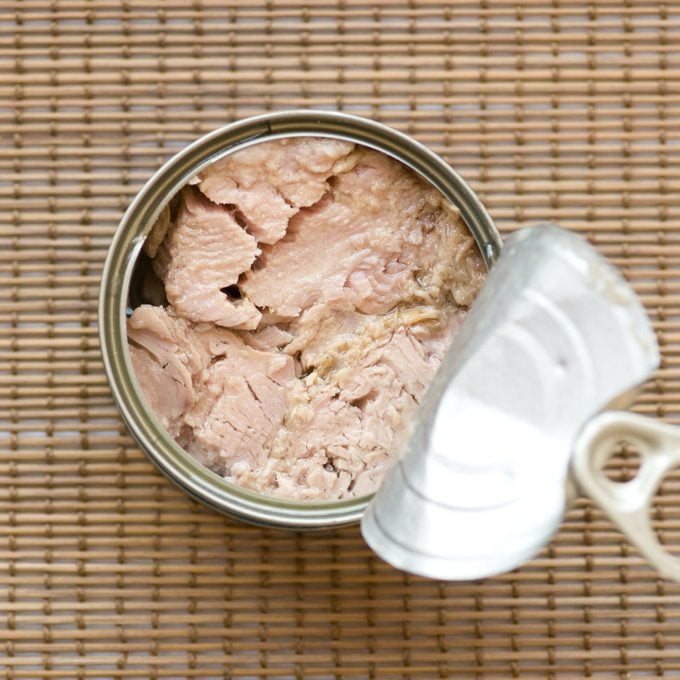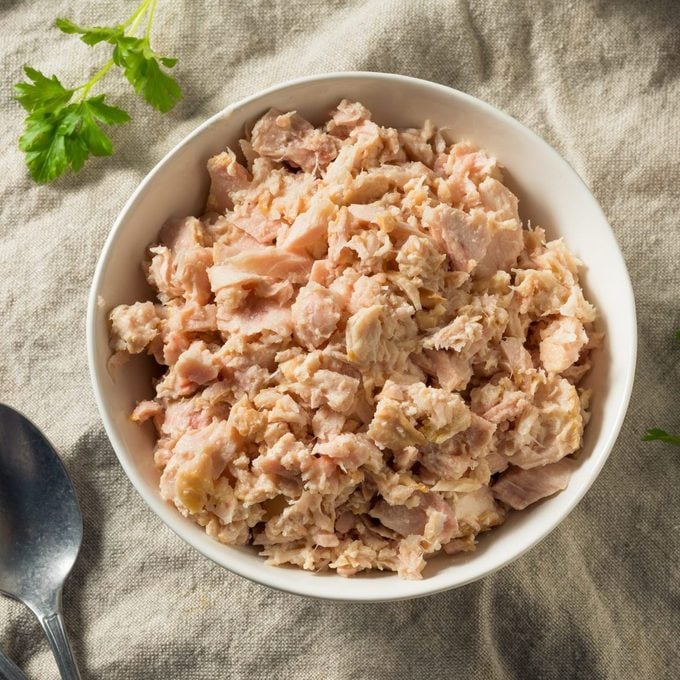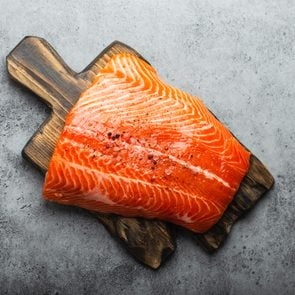Is Canned Tuna Healthy? 4 Benefits You Should Know About
Updated: Oct. 19, 2021
Is canned tuna healthy? The short answer is yes, absolutely! Learn more about what registered dietitians have to say.
Is canned tuna healthy?
Canned tuna isn’t only delicious. It’s also one of the top nutritious convenience foods out there: You get a whole lot of protein in one single can.
“It’s an inexpensive source of protein and is relatively low in calories,” says Susan Taylor, a registered dietitian in Charleston, South Carolina.
And there’s even more to canned tuna. Experts explain tuna benefits and why it’s a healthy addition to your diet. Plus, how to shop for canned tuna, how to prepare it, and more.
Different types of canned tuna

If you’re confused in the canned tuna aisle, you’re not alone. Plenty of options exist, and some are better than others.
“There are a lot of varieties!” says registered dietitian nutritionist Jen Bruning, a spokesperson for the Academy of Nutrition and Dietetics, in Chicago.
“Generally, tuna is a fish to be aware of when it comes to mercury content. Some canned tuna, like albacore, contains more mercury,” Bruning says.
“Try looking for skipjack or yellowfin, sometimes packaged as ‘light’ tuna, which contain less mercury.”
And look for water-packed tuna, versus the oil-packed type.
“Be aware of sodium, too,” Bruning adds. “While not super high in sodium, canned tuna does have around 200 milligrams per serving. And use salt sparingly with canned tuna recipes.”
Albacore vs. tuna
Are you wondering about the differences between albacore and tuna? Well, albacore is one of several types of tuna.
“It’s a large fish, which means it has eaten smaller fish that also contain mercury,” Bruning says. “This causes a buildup of mercury over time.”
Other types of tuna like skipjack and yellowfin are smaller fish that contain less mercury because they are lower on the food chain than albacore, according to Bruning. Due to the mercury risk, pregnant women, nursing moms, and young children should limit albacore tuna intake.
Different types of tuna differ in terms of nutrition, too.
“Albacore tuna contains 733 milligrams of omega-3 fatty acids per 3-ounce serving,” says Jody Bergeron, MS, RN, a critical care nurse for Cape Cod Healthcare in Mashpee, Massachusetts. “This is compared to light tuna, which contains 228 milligrams in the same serving.”
The eicosapentaenoic acid (EPA) and docosahexaenoic acid (DHA) omega-3s found in fish are beneficial for brain health, heart health, and more.
Albacore vs. salmon
People often ask about the differences between albacore and salmon. So here goes: Albacore is a type of tuna, and salmon is, well … salmon. Both are fish.
“The most notable difference between tuna and salmon is omega-3 content,” Bruning says.
“Salmon contains a lot more. For this reason, salmon can have a greater cumulative effect on your health when you eat it more often.”
Here are the salmon benefits to know.
Bruning notes that salmon also contains more vitamin D, a nutrient of concern for Americans, than tuna. On the other hand, she says, tuna contains more protein per serving due to its being leaner than salmon.
Where canned tuna comes from
The tuna in your can may originate from a variety of places. Most of it comes from the Pacific Ocean—and other fishing sources include the Indian Ocean, the Atlantic Ocean, and the Mediterranean Sea, according to the Colorado School of Public Health. Canned tuna processing plants are primarily located in Southeast Asia.
Americans are one of the top consumers of canned tuna—alongside folks in Japan and the European Union.
How to shop for canned tuna
You’ll find canned tuna packed in either water or oil.
“Bisphenol A (BPA) binds with fat such as oil, so look for BPA-free cans when choosing canned tuna in oil,” says Jennifer Fiske, a registered dietitian nutritionist in Dallas-Forth Worth. “If glass packaging is an option, opt for glass.”
Choose water-packed tuna when you can to cut down on calories and fat.
And think about how you’ll want to use your canned tuna.
“Canned tuna is available as solid or chunk, which tells you if the tuna is in large or flaky pieces,” Bruning says. “Solid canned tuna is great on a salad or toast, whereas chunk is easily mixed into pasta or a condiment.”
And if you want to choose certified sustainable seafood, look for the Marine Stewardship Council (MSC) blue label on a product’s package.
Canned tuna health benefits

Is canned tuna healthy? Absolutely. You’ll get many health benefits from eating canned tuna.
“Tuna provides protein and fat, which are great for helping to balance blood sugar,” Fiske says. “Specifically, tuna provides omega-3 fatty acids, which are linked to a myriad of health benefits. Omega-3s in seafood may help lower triglycerides and inflammation and help increase ‘good’ HDL cholesterol.”
Plus, you get a whole bunch of vitamins and minerals from tuna.
“One mineral that may not get as much attention as it deserves is selenium, which helps protect against cell damage,” Bruning says.
“Three ounces of canned tuna provides all the selenium that you need in a day. Selenium can also help protect against damage due to mercury intake.”
Canned tuna also provides iron, vitamin B12, and vitamin D. There aren’t too many go-to food sources of vitamin D around, so this benefit is especially noteworthy.
Canned tuna and disease prevention
Eating canned tuna can help improve your vitamin D and omega-3 intake.
“Adequate vitamin D and omega-3 intake have been linked to helping prevent cardiovascular disease, cognitive decline, some cancers, and diabetes,” says registered dietitian nutritionist Erin Pettygrove, owner of NutritionRx in San Jose, California.
And eating seafood like tuna could help you age more gracefully.
“A 2018 study in BMJ looked at the association between blood levels of omega-3s from seafood and healthy aging,” Fiske says.
“Participants with higher levels of omega-3s showed healthier aging and decreased risk of chronic disease, as well as serious mental or physical problems. Even though ALA (alpha-linolenic acid) from plants also provides omega-3s, this form did not show the same association with healthy aging.”
Canned tuna nutrition facts
Here are the nutrition facts for canned tuna, including the recommended daily values (DVs) for a 3.5-ounce serving:
- Calories: 85
- Total fat: 1 gram (1 percent DV)
- Protein: 19 g (38 percent DV)
- Carbs: 0 g (0 percent DV)
- Sodium: 219 g (10 percent DV)
- Iron: 2 g (11 percent DV)
How much canned tuna to eat

If you go by the 2020-2025 Dietary Guidelines for Americans, adults should aim for two 4-ounce servings of seafood per week. Many experts recommend eating up to 12 ounces per week.
“To take mercury levels into account, albacore tuna would be [a maximum of] about 4 ounces per week, and light tuna would be [up to] about 8 ounces a week,” Bergeron says.
A chart from the U.S. Food and Drug Administration (FDA) helps you choose which fish to eat and how often based on mercury content. Canned light tuna is a “best” option, albacore and yellowfin tuna are “good” options, and bigeye tuna is a choice to avoid. Again, this is because of its very high mercury content.
Of course, you have to think about more than just your tuna consumption.
“Also, keep in mind other fish types that you eat—a fish like swordfish is also high in mercury,” Bruning says. “Try not to eat two types of high-mercury fish the same week on a regular basis.”
Check out the best fish to eat, and the kinds to avoid.
Risks and side effects of canned tuna
Is canned tuna healthy? The main concern with tuna is overdoing it and taking in too much mercury.
“Eating too much of any high-mercury fish on a regular basis can cause a buildup of mercury in bodily tissues,” Bruning says.
“This is mainly an issue for pregnant women and young children, as brain development can be affected by mercury. People living in areas contaminated by industrial pollutants will want to take caution with any locally caught fish.”
Also, while tuna does boast omega-3s, it doesn’t have as much as some other seafood—such as salmon, sardines, and anchovies.
How to eat canned tuna
Give these delicious tuna recipes a try:
- 30 Easy Canned Tuna Recipes
- Tuna Thai Red Curry from Rebecca Pytell, RD
- Tuna Avocado Salad from Elysia Cartlidge, RD
- Delicious Tuna Salad from Jamie Feit, RD
- Tuna Cakes from Shahzadi Devje, RD
- Tuna Noodle Potato Chip Casserole from Julie Kay Andrews, RD
- Spicy Tuna Bowl from Erica Julson, RD
Now that you can confidently answer the question “is canned tuna healthy,” check out the best tuna brands.



